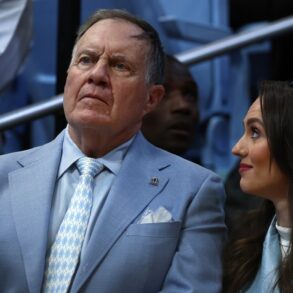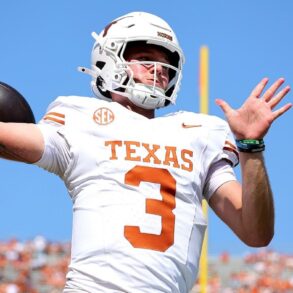While many focused on the NFL draft this week, a court ruling shook college football.
The future of the so-called NCAA-House lawsuit settlement, which was expected to take effect July 1 and reshape how college programs manage their rosters and compensate players, was thrown into uncertainty Wednesday by a judge’s ruling.
Assuming that the settlement would be finalized, major conferences and college athletics programs had jumped the gun a bit and moved ahead with plans to follow the proposed rewrite of the rule book, which would bring about significant changes, including revenue sharing with athletes; new rules for managing name, image and likeness deals; and changes to scholarship and roster limits.
In the deal, commonly referred to as the House settlement after lead plaintiff Grant House, the NCAA agreed to pay roughly $2.8 billion in damages to past and current athletes to settle three federal antitrust lawsuits that claim the association’s rules had limited athletes’ earning potential. The settlement also would create a system for schools to pay players directly, starting this summer, through revenue sharing.
In exchange, the NCAA would be allowed to limit how much each school can spend on its athletes per year — an effective salary cap that is expected to start at roughly $20.5 million per school and increase annually during the 10-year lifespan of the deal.

Former UGA quarterback Carson Beck got $4 million to move to Miami. Tennessee QB Nico Iamaleava reportedly wanted that much, too, but didn’t get it and wound up at UCLA. (Hyosub Shin/AJC) (HYOSUB SHIN / AJC/Dawgnation)
The settlement also includes new limitations on third-party NIL deals, which will have to be approved by a clearinghouse.
With that in mind, ESPN reported the power conferences had contracted with auditing giant Deloitte to review booster collective NIL deals and decide whether each is a legitimate endorsement contract or a veiled attempt to circumvent the salary cap.
And Georgia head coach Kirby Smart is on board with that, saying recently that “if the clearinghouse/Deloitte has teeth and can police deals and make deals legitimate deals, fair market value deals, then we possibly have a chance. But there’s people out there that question whether that can even happen. Look, we live in a litigated society.”
There’s a whole other issue though: While the settlement would allow UGA and other Division 1 schools to provide full scholarships to all athletes, their football rosters, which have averaged around 128 players, were expected to be limited to 105.
Naturally, objections had been raised to the roster limits, and Smart was among those expressing strong concerns about the potential elimination of walk-on players, which hold a particularly fond spot in UGA football lore — that’s how Stetson Bennett came to be a Dawg.
Ultimately, though, it was indeed the roster limits — which many schools already were putting in motion — leading some athletes to enter the spring transfer portal — that proved to be a sticking point with U.S. District Judge Claudia Wilken, who said this week that programs shouldn’t have proceeded with such plans without her final ruling.
“Any disruption that may occur is a problem of Defendants’ and NCAA members schools’ own making,” she wrote, giving the litigants in the suit 14 days to return to the bargaining table.
If they can’t reach agreement, the original lawsuits likely will go to trial this fall, and the future of college athletics will be even more uncertain than it already was.
“The fact that the Court granted preliminary approval of the settlement agreement [last October] should not have been interpreted as an indication that it was certain that the Court would grant final approval,” Wilken said.
The judge has made it clear that she would like the parties to find a way to implement roster-limit rules gradually.

College football keeps changing, but one thing you can bet on: Fans will be asked to pay more. (Hyosub Shin/AJC) (Hyosub Shin/Dawgnation)
“One way of achieving that could be to modify the settlement agreement to ensure that no [athletes] who have or had a roster spot will lose it as a result of the immediate implementation of the settlement agreement,” she wrote. “Limits could be accomplished gradually by attrition.”
So, the plan on which college athletics leaders had based their plans, now is up in the air.
That leaves college football with the increasingly chaotic situation typified by the recent breakdown in negotiations that saw Tennessee quarterback Nico Iamaleava leave the Vols — apparently because he couldn’t get certain guarantees, including a sizable raise in his NIL money from UT’s Spyre Sports Group collective, which would have paid him $2.4 million this year.
Iamaleava reportedly wanted more like the $4 million Miami used to lure Carson Beck away from the NFL draft, though when the former Vols QB finally landed back in his native state of California at UCLA, he reportedly ended up with considerably less money than that.
That sort of situation is just a fact of life for college football coaches these days. As Smart said after the G-Day game, “there’s definitely more agents involved in the process this year than previous years, and it will continue to grow in terms of representation. But the agents are just doing a job, just like I’m doing a job, just like the parents do a job. Their job is to protect their client, try to get the best deal or the best situation for their client they can. And I understand that. That is a business side of it. I don’t think that’s a bad thing.”
Still, from the coaches’ point of view, it’s hard to build a successful program when you can’t be sure that your starters aren’t already looking elsewhere — one reason for the coaching paranoia that resulted in many schools, including Georgia, pulling their spring games off TV this year, so as not to provide other coaches with a handy talent shopping list.
As it turned out, Georgia’s losses to the spring transfer portal weren’t monumental. The portal closed Friday with four Georgia Bulldogs having entered it — oft-injured running back Branson Robinson, suspended wide receiver Nitro Tuggle, offensive lineman Marques Easley and defensive back Chris Peal.
Still, the difficulty of maintaining and building a roster from one season to the next remains for Smart and other coaches.
So, how to tame the “wild West” that roster management in college sports has become?
Just over a year ago, I wrote in the Blawg that “one of these days, we might see college sports move to collective bargaining and employment contracts with players, which might sound awful to tradition-bound fans, but would at least end this everyone’s-a-free-agent anarchy.”

Some fear that new roster limits would do away with players like Stetson Bennett making the team as walk-ons. (Curtis Compton/AJC) (Curtis Compton / Curtis.Compton@ajc.com/Dawgnation)
More observers of the sport are coming around to that way of thinking — or something similar — in order to corral the NIL world with the sort of limitations and rules that are commonplace in the business world. (And, make no mistake, college football is big business.)
USA Today’s Matt Hayes recently offered what he sees as a solution: adding hefty buyout clauses to NIL deals, in the same way that schools structure coaches’ contracts.
The current situation, Hayes correctly noted, is an “unbridled mess.”
But, he continued, “what did college football’s braintrust think was going to happen when the figurehead NCAA followed orders from the power conference presidents in 2021 to set up a system that allowed unregulated name, image and likeness deals — and free player movement?”
Hayes was thinking along the same lines I did a year ago when he wrote that the easiest way to solve the problem “is one college sports continues to avoid at all cost: employee status, contracts and collective bargaining.
“Absent that, we’re forced down the nonsensical road of maybe Congress will help with federal legislation (it won’t). Or maybe the NCAA can come up with ‘guardrails’ that won’t be challenged in court (they will).
“I’ve seen this dance before, and it doesn’t end well for all things NCAA.”
However, if you treat the players the same way you do the coaches and add an addendum to their deals that outlines a fee to be paid to the employer (the school) if the employee (the player) wants to leave to go elsewhere, it will at least cause some players to think twice.
Maybe they’ll go ahead and pay the buyout themselves; maybe they’ll try and get their new school to pay it; or maybe they’ll stay put.
A legally binding contract is the way to discourage holdouts like Iamaleava, who failed to show up one day for spring practice because he hadn’t gotten what he wanted.

Georgia head coach Kirby Smart says of the current chaotic nature of college football: “It is what it is.” (Hyosub Shin/AJC) (HYOSUB SHIN / AJC/Dawgnation)
Whatever rules are adopted, there is one certainty: Fans will be asked to pay more and more.)
Of course, even if the two sides in the House case come to terms and the judge signs off on the deal as previously been outlined, that won’t necessarily stem the flow of players into the portal, as Georgia’s Smart noted at his press conference after the G-Day game.
“I don’t know that the House settlement is going to have any effect on the flow of players because that’s not really what the House settlement is meant to do,” he said.
In fact, he said, “it could increase [the flow to the portal] if more teams have money.
“I think it’s hard to say what’s going on in our league, how that will impact things in the future. I can’t foresee that. I think it’s been spiraling and it’s continuing to spiral. So, I don’t know what reigns it in. I don’t know that there’s anything anybody can do to reign it in. It is what it is.”
In the end, Smart said, “you have to manage your culture as good as you can. You have to manage the players you take as good as you can. And you’ve got to move on and play with the players that are there.”
True, but I think that job would be considerably easier for Smart and other coaches if college sports would just bite the bullet and make the athletes employees.
The NCAA’s longtime “amateurism” myth is long dead, so it’s time to acknowledge that college football, which generates more than a billion dollars a year, should be run like a business.

What is UGA Athletic Director Josh Brooks’ No. 1 bucket list item? (University of Georgia) (University of Georgia/Dawgnation)
SOUNDS LIKE A WINNER
This month’s Brooks Bulletin email newsletter sent out by Josh Brooks included a brief Q&A unrelated to sports at the bottom.
Of particular interest to me was to Brooks’ answer to the question “What is the No. 1 item on your bucket list?”
Replied the UGA athletic director: “Having R.E.M. headline a concert in Sanford Stadium!”
Sounds like the sort of once-in-a-lifetime opportunity that just might bring the Athens band’s members back together for a show.
After all, the members of R.E.M. long have shown their devotion to Athens and to UGA (such as letting the band’s “Oh My Heart” be used in a 2011 TV promotional spot that aired during UGA football telecasts).
I’m all for an R.E.M. concert at Sanford, especially if football season ticket holders are offered first-crack at tickets!
FOLLOW THE BLAWG
To keep up with the latest UGA athletics developments, as well as other stuff going on in the Junkyard, be sure to go to Bill King’s Junkyard Blawg page on Facebook and click “like” to follow it!
This post was originally published on this site be sure to check out more of their content.





